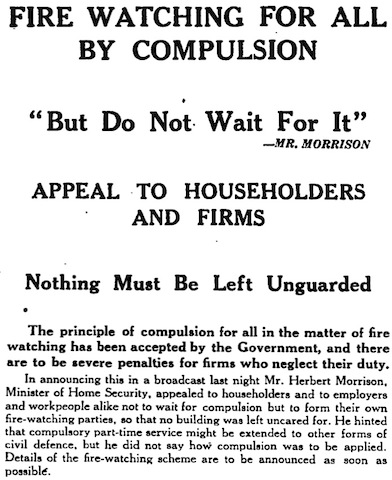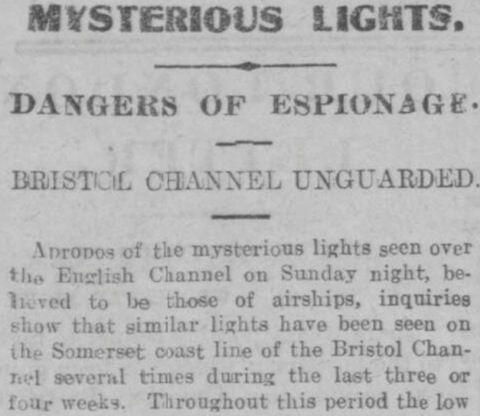
Captain Lindsay’s appeal for other witnesses to the airship he saw at Cardiff has not been in vain. A number of newspapers today print the same brief paragraph noting the existence of ‘other eye-witnesses’ (not named) — the syndicalist Daily Herald, p. 7; Dundee Courier, p. 6; Liverpool Echo, p. 5; Manchester Courier, p. 10; and Standard, p. 9 (above); while The Times, p. 10, has an even more abbreviated version — which adds:
After leaving Cardiff the course of the airship was altered from due west to north-west. It is said to have carried a light and travelled so fast that when one observer ran to a telephone the airship had almost disappeared.
Fortunately, the Globe provides some more substantial details (p. 5):
Mr. Stephen Morgan, of Merthyr, states that he saw ‘something resembling an airship’ about 6 p.m. on Friday [17 January 1913], that it carried a light, and that it left a column of smoke in its wake.
Mr. E. Morgan, of Roath, Cardiff, states that when he saw the ship the light was too dim to see its lines clearly, but that it appeared to be ‘oval-shaped.’
In addition, ‘It is declared’ (by whom?) ‘that a fortnight ago an airship was seen at night over Barry Dock‘.
The Globe also reports two new mystery aircraft sightings (or hearings):
The ‘Eastern Daily Press’ publishes a statement by Mr. Herbert A. Pertwee, of 104, North Denes-road, Yarmouth, that between midnight and 1 a.m. on January 15 he heard an airship or aeroplane pass over his house, return, then fade away. The Wolverhampton ‘Express and Star’ states that several people at Hednesford saw an airship bearing a light at 7.30 p.m. on Sunday last [19 January 1913].
Yarmouth is on the Norfolk coast, facing Germany across the North Sea; but Hednesford is in Staffordshire in deepest England, the first report to come from inland.
The Standard appends to its brief paragraph on the Cardiff airship a quite substantial summary of ‘these secret night flights’, asking ‘Does Germany hold the secret?’ (p. 9). As it says, ‘The record is worth recapitulating’, so it is recapitulated here in full:
October 14, 1912. — Many witnesses, including naval officers at Sheerness, heard the noise of the engines of a dirigible and saw it hovering in the air at Eastchurch. Guiding flares were lit by officers of the Royal Flying Corps, but the airship disappeared. No machines were out that night from the Naval Aviation School at Eastchurch.
October 13-14. — New Zeppelin airship attached to the German navy passed over Borkum and Norderney with Count Zeppelin and 21 men on board, and was seen going out to the North Sea.
October 14. — The Hausa [sic], a Zeppelin airship stationed at Hamburg, flew to Brunswick and Gotha, arriving at 4 p.m.
October 15. — The Zeppelin naval airship returns to Kiel at 2 a.m. German official account says the flight started on October 12 and ended at Johannisthal, near Berlin, on the afternoon of October 14.
November 18. — Mr. Winston Churchill promises, in answer to Mr. Joynson Hicks, that ‘inquiries will be made. Colonel Seely states that Zeppelin airships are reported to have attained a speed of 50-60 miles per hour, and some of the later types to have accomplished distances of 800 miles in 30 hours without descending to earth.
November 20. — Count Zeppelin denies that any of his airships approached the English coast on the night of October 14.
November 21. — Mr. Churchill states in the House that he has ascertained that an unknown aircraft was heard over Sheerness about 7 p.m. on the evening of October 14, there being no evidence to indicate its nationality.
November 27. — Mr. Churchill admits that the airship was not one of our craft, and that we have not any airship equivalent in size and power to a Zeppelin, or any airship capable of travelling at the rate of 60 miles an hour.
January 4, 1913. — A mysterious airship is seen at daybreak travelling from the sea in a north-easterly direction over Dover, the prevailing wind blowing half a gale.
January 6. — Mysterious lights, said to be the lamps of an airship, seen over the Bristol Channel in the neighbourhood of Nell’s Point, Barry, and Lavernock, where there are important forts forming part of the chain of defences protecting our coal-shipping ports.
January 13. — It is stated in the Press that ‘there is reason to believe that the mysterious airship which visited Sheerness at night and more recently Dover is the Hausa [sic], a Zeppelin airship which is not in the possession of the German Government.’
January 17. — At Cardiff Captain Lionel Lindsay, the Chief Constable of Glamorganshire, sees at 4.45 p.m. an airship, bigger and faster than the Willows craft, moving towards Swansea.
There then follows an analysis of German airship dispositions and capabilities — ‘within seven hours’ flight of us is an aerial navy with which, on Mr. Churchill’s admission, we have not an airship to compare’:
Two air vessels at least will shortly be established at Heligoland, 350 miles from the mouth of the Thames, where concealed airship sheds, sinking in the manner of a gasometer and revolving to facilitate the entrance and exit of craft in a wind, are about to be constructed. Hamburg and Cuxhaven will also harbour two air vessels, and Kiel, where a shed is now being constructed, at least one airship, an auxiliary to the Hamburg craft. Altogether, it is believed, 14 new airship sheds are being constructed in Germany, each of which, in addition to housing the dirigible, will be equipped with aeroplanes, spare parts and stores, mechanics, and relief crews.
Finally, the Standard says that a nonstop return flight across the North Sea ‘is easily within the capacity of the present German Zeppelins’. The Hansa (finally getting the name right here) averaged 43.5 miles an hour on its flight from Hamburg to Gotha, while the German navy’s Zeppelin was airborne for 31 hours, ‘according to the official version’.
If this vessel indeed accomplished the journey from Friedrichshafen to Sheerness, via Borkum, and back to Johannisthal (Berlin) via Fehmarn Island (Baltic) — a total distance of 1350 miles — her speed would be some 43 miles per hour.
It’s not clear why Fehmarn Island was suddenly introduced here, unless it’s as a waypoint to make the distance flown come out to 31 hours times 43.5 miles per hour. And there is still the problem that the naval Zeppelin had already ended its flight some hours before the Sheerness incident. But it’s clear that the Standard isn’t willing to take the German government’s word at face value.
![]() This work is licensed under a Creative Commons Attribution-NonCommercial-NoDerivatives 4.0 International License.
Permissions beyond the scope of this license may be available at http://airminded.org/copyright/.
This work is licensed under a Creative Commons Attribution-NonCommercial-NoDerivatives 4.0 International License.
Permissions beyond the scope of this license may be available at http://airminded.org/copyright/.






Pingback: Monday, 27 January 1913
Pingback: Saturday, 22 February 1913
Pingback: Thursday, 30 January 1913
Pingback: Thursday, 23 January 1913
Pingback: Saturday, 8 March 1913 | Airminded